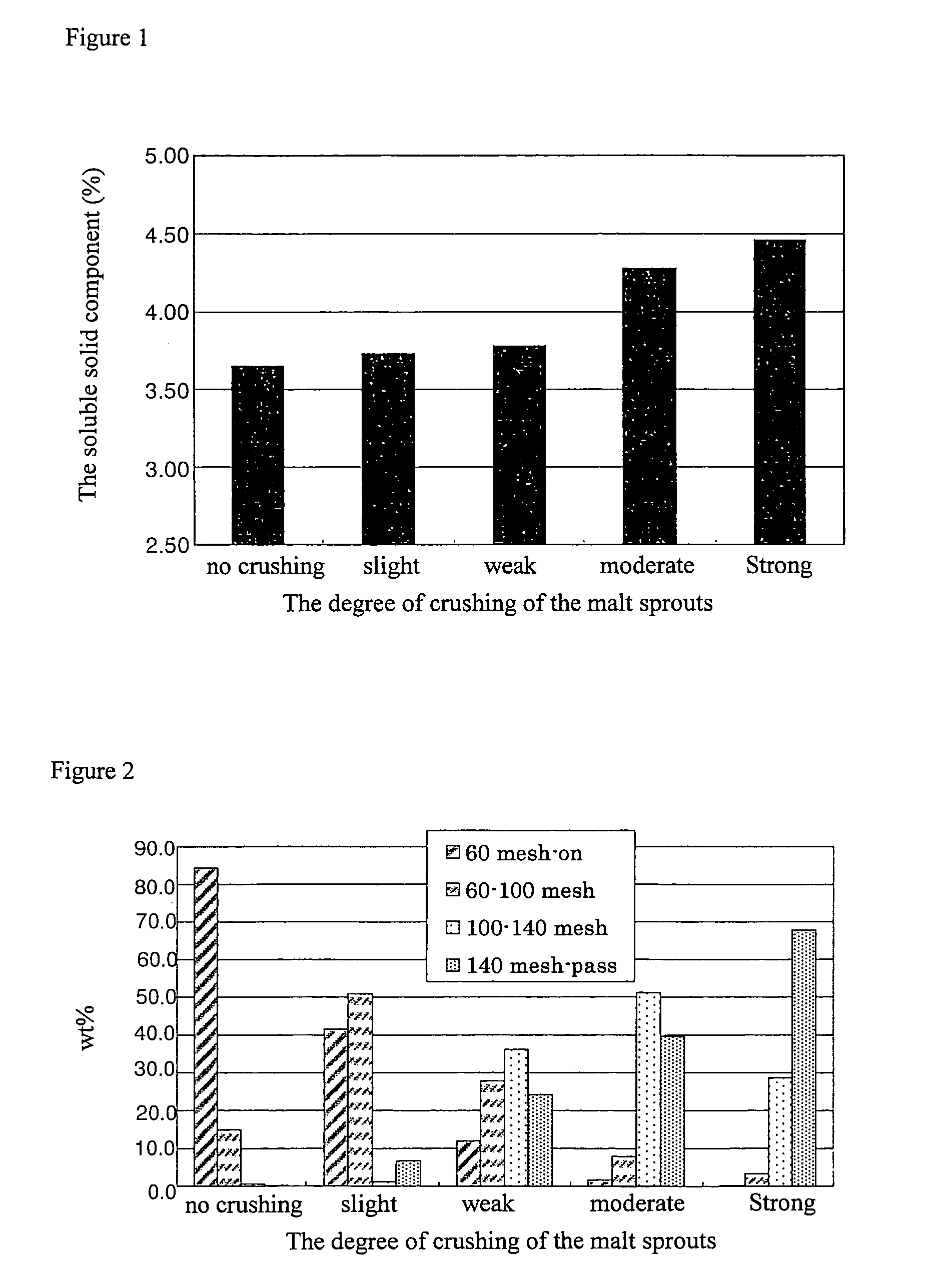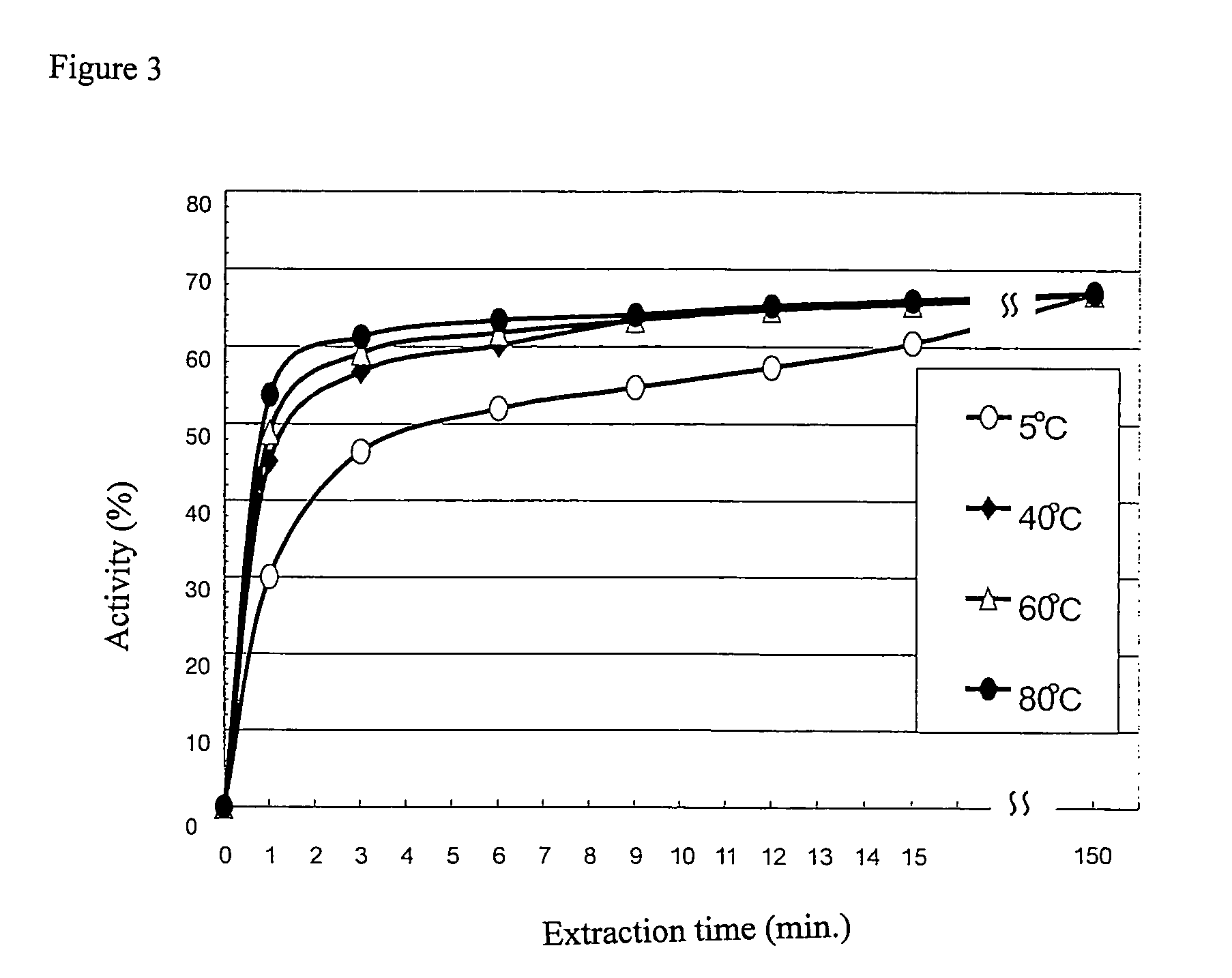Process for producing food and beverage products from malt sprouts
a technology of malt sprouts and food and beverage products, which is applied in the direction of biochemistry apparatus and processes, beer brewing, beer fermentation, etc., can solve the problems of giving beer and other beverages unpleasant flavors, and achieve the effects of reducing the unpleasant flavor of malt sprouts, improving the flavor of immersion liquid, and reducing the degree of crushing
- Summary
- Abstract
- Description
- Claims
- Application Information
AI Technical Summary
Benefits of technology
Problems solved by technology
Method used
Image
Examples
example 1
[0056]To find an effective method of using malt sprouts in making food and beverage products without adding the unpleasant flavor of the malt sprouts, malt sprouts were crushed to different degrees and were immersed in a liquid. The resulting immersion liquids were evaluated.
[0057]To prepare malt sprouts crushed to different degrees, domestically produced malt sprouts were used as a representative sample of malt sprouts marketed as a by-product produced in malting facilities. 3 kg of the malt sprouts were put in a plastic bag and were gently mixed until uniform. Using a shovel, the malt sprouts were divided into 5 bags in 700 g portions. Each bag was milled in a stone mill (Micropowder, Tokusyu Kika Kogyo Co., Ltd.) operated by compression shearing. Specifically, by turning the particle size adjuster dial, the lower millstone of the mill was vertically moved to adjust the clearance between the upper millstone and the lower millstone to five different levels. In this manner, the five...
example 2
[0065]As in Example 1, a weakly crushed malt sprout was prepared and was subjected to the sieve analysis. The flavor of each of the resulting immersion liquids was evaluated. Specifically, a predetermined amount of the weakly crushed malt sprouts obtained in the same manner as in Example 1 was sieved through three differently sized sieves according to JIS Z8801 (60, 100, 140 traditional mesh) on a sieve agitator (Electric sieve ANF-30, Nitto Kagaku Co., Ltd. 2800 rpm, 15 min). The traditional mesh sizes of 60, 100 and 140 correspond to 250, 150 and 106 μm as measured in the standard mesh size, respectively. The sieving gave four fractions each having a different particle size (i.e., less than 106 μm, 106 to 150 μm, 150 to 250 μm and 250 μm or greater). 50 g of each fraction were immersed in 500 ml of 80° C. hot water and were left for 15 min to allow the components of the malt sprouts to seep out in water. Subsequent solid / liquid separation gave an immersion liquid. The flavor of ea...
example 3
[0075]The malt sprouts with five different degrees of crushing (i.e., strong, moderate, weak, slight and no crushing) used in Example 1 were subjected to the sieve analysis to determine the particle size distribution for the malt sprouts crushed to each degree of crushing. Specifically, 200 g of each of the malt sprouts crushed to each degree of crushing were sieved through three sieves having different mesh sizes according to JIS standards (i.e., 60, 100 and 140 traditional mesh) on the sieve agitator. This gave four fractions with different particle sizes (i.e., less than 106 μm, 106 to 150 μm, 150 to 250 μm and 250 μm or greater). The particle size distribution of each fraction was determined.
[0076]The results are shown in FIG. 2.
[0077]As can be seen from FIG. 2, approximately 90% or more of the strongly and moderately crushed malt sprouts was composed of particles sized less than 150 μm (i.e., the less-than-106 μm fraction and the 106 to 150 μm fraction combined), which form the...
PUM
| Property | Measurement | Unit |
|---|---|---|
| particle size | aaaaa | aaaaa |
| particle size | aaaaa | aaaaa |
| particle size | aaaaa | aaaaa |
Abstract
Description
Claims
Application Information
 Login to View More
Login to View More - R&D
- Intellectual Property
- Life Sciences
- Materials
- Tech Scout
- Unparalleled Data Quality
- Higher Quality Content
- 60% Fewer Hallucinations
Browse by: Latest US Patents, China's latest patents, Technical Efficacy Thesaurus, Application Domain, Technology Topic, Popular Technical Reports.
© 2025 PatSnap. All rights reserved.Legal|Privacy policy|Modern Slavery Act Transparency Statement|Sitemap|About US| Contact US: help@patsnap.com



